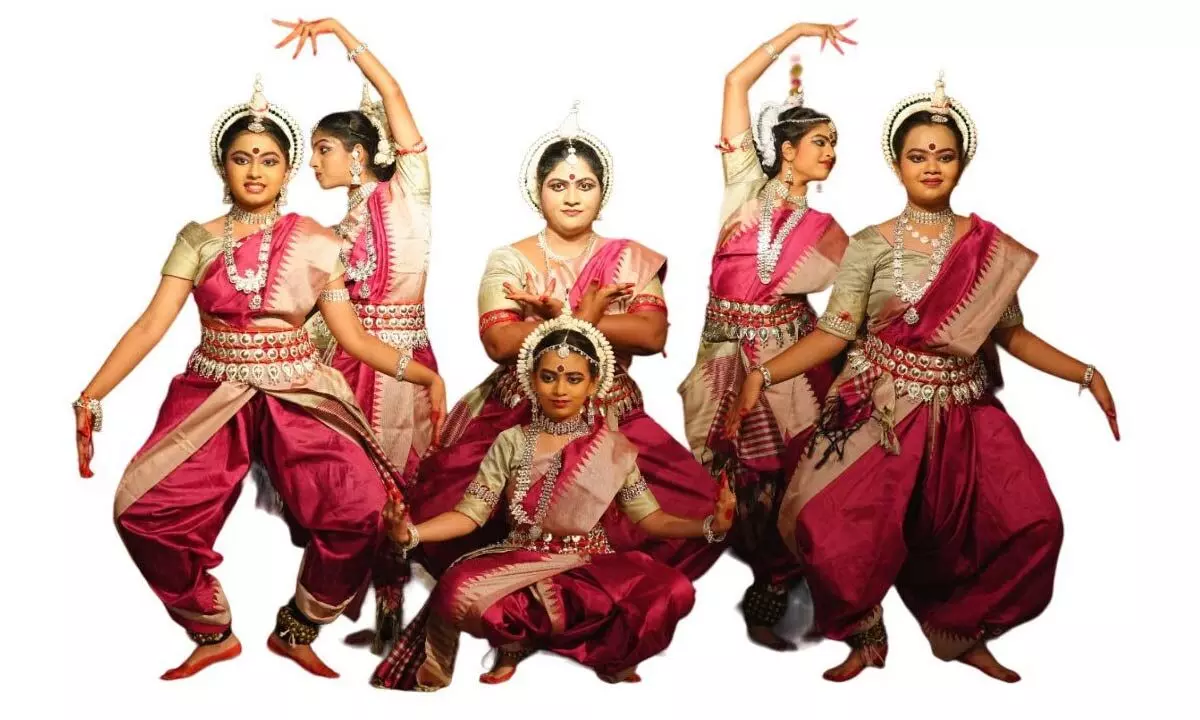Live
- They always want me to win, and now I feel lucky to have been offered a story like ‘Zebra’: Satyadev Kancharana
- ‘Democracy first, humanity first’: PM Modi in Guyana's parliament on two countries' similarities
- PKL Season 11: Telugu Titans register third straight win to top standings
- Is Pollution Contributing to Your COPD?
- NASA Unveils Underwater Robots for Exploring Jupiter's Moons
- Additional Central forces arrive in violence-hit Manipur
- AR Rahman and Saira Banu’s Divorce: Legal Insights into Common Issues in Bollywood Marriages
- 82.7 pc work completed in HPCL Rajasthan Refinery area: official
- Curfew relaxation extended in 5 Manipur districts on Friday
- Tab scam prompts Bengal govt to adopt caution over fund disbursement
Just In
Exploring the Rich Tapestry of Odissi Dance at Utsav Festival


Odissi Sandhya - An Evening Filled With An Entrancing Introduction To The Odissi Dance Form Of Orissa
Odissi dance has a long and memorable history, as witnessed by the sculptures and rituals of the famed Jagannath temple. For centuries, the revered Maharis served Lord Jagannath, with dance being a highly important part of the daily temple rituals. This highlight and glory of Odia culture were recreated and saved after a long hiatus by legendary gurus like Kelucharan Mohapatra and Pankaj Charan Das, along with many others. The graceful nature of this art form consists of the “Tribhanga” pose, where the body bends in different directions at the knees, hips, and neck, and measured meticulous steps are performed in intricately swirling movements of the body, calculated with the utmost precision, as the slow pace does not permit mistakes to go unnoticed.
At Lamakaan on Saturday, Hyderabad Odissi Utsav, an initiative of Shyamhari Chakra, featured the Odissi Dancers of the Twin Cities in their second annual celebration showcasing Gurus Priyanka Mishra, Arpita Pani, Varsha Panda, and students of various institutions, including a Guest Artiste who is also a prominent Odia film actress - Sangeeta Dash. Odissi Sandhya started with Sampriti Mohanty, a student of Guru Vishnu Samal, performing Nabadurga based on the divine Mother Goddess, who has nine different forms and killed Sumbha and Nisumbha to restore peace and tranquility to the world. Sangeeta performed the poignant Jayadeva Ashtapadi “Yahi Madhava” with a classic finish befitting a senior world-renowned dancer, depicting the plight of Radha who lashes out at Krishna in angry envy, suspecting his dalliance with another woman, as shown by his appearance. Radha spent a sleepless night with a heavy heart, but when Krishna came to console her, she noticed his tired and red eyes, clearly indicating that his concern was false. So, she rejects his explanations and tells him to go back to the other lady who has made him happy enough to forget her. So realistically did the dancer portray Radha’s grief that the audience was reduced to tears, absorbed in rasanubhava evoked by her skill. Students of Guru Debashree Patnaik’s Nirmalya Odissi Academy essayed Basant Pallavi, which is similar to thillana in other dance forms. In this pure dance item, the raga is elaborated through eye movements, body postures, and intricate footwork. Pallavi literally means blooming. This is applicable not only to the dance but also to the music that accompanies it.
The name of the dance item is always based on the raga of the song attached. Slow, elegant movements of the eyes, neck, torso, and feet build up to a crescendo, climaxing in a fast tempo at the end. “Asthasambhu” in Malkosh, written by Kavi Venkateswar, belongs to the abhinaya stage in the Odissi traditional format, which is completed in five different stages, namely Mangalacharan, Sthai, Pallavi, Abhinaya, and Mokshya. It was competently performed by Purnima Piyali. Sanjukta Ghosh brought out the contrasting male (tandava) and female (lasya) energies, which are soft and strong but complement each other, working in harmony as contained in “Shiva Parvati Shabda.” Shabda nritya originated from Kumhari in the western part of Orissa. Mangalacharan - “Namami” was done by Saesha Mishra and Tanvi Upasana, students of Sonali Mohanty, invoking the boon-bestowing Lord Ganesha with an immense body and tusks. The son of Shiva, who loves dance and removes obstacles, is saluted.
Senior Guru Preeti Mohapatra is the founder of Nrityashala school of Odissi dance. Her student and daughter Akshita Mohapatra shone in “Khede Chhanda” as she showed Krishna slaying the demons with energetic nritta combined with sensitive abhinaya. Banamali Das, a great poet, describes the slaying of Shakatasura, Kaliyadamana, and ends with Vishwarupa when the Lord opens his mouth to reveal the entire universe contained within. The astonishment of Yashoda, as she forgets to chide Krishna in awe of his divine nature, was finely depicted. She alternated between being a valiant Krishna and the fearsome subdued demons in realistic death throes. Her expressive dance full of energy gives promise of a young talented artiste in the making who also excels in her academic studies as she pursues a career in graphic design in the U.S. Bijayalakshmi Nayak performed Kalavati Pallavi. She was able to clearly delineate the mood and subtle nuances of the explored raga, transforming it into soft and fluid movements. Many budding young dancers - Abha, Palak, Ira, Ruhani, Nandita, Aradhya, and others also participated. Appreciation is due to the organizers’ unwavering commitment and tireless efforts in bringing such a large spectacle containing so many dancers to life.

© 2024 Hyderabad Media House Limited/The Hans India. All rights reserved. Powered by hocalwire.com






